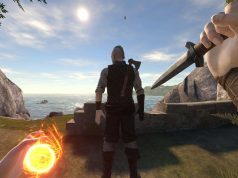 Blair Renaud is the creator of Technolust, and he talks about his strategy for creating different experiences out of the Technolust universe for the Vive, Playstation VR, Oculus Rift, and Gear VR. Technolust has been one of the early VR adventure games, and so Blair has been on the forefront of trying to find a good VR locomotion solution that is comfortable for the majority of users. He explains their flexible dungeon crawler locomotion scheme that they’re calling “Cloudstep”, as well as some of their strategies for overcoming the uncanny valley with realistic social behaviors.
Blair Renaud is the creator of Technolust, and he talks about his strategy for creating different experiences out of the Technolust universe for the Vive, Playstation VR, Oculus Rift, and Gear VR. Technolust has been one of the early VR adventure games, and so Blair has been on the forefront of trying to find a good VR locomotion solution that is comfortable for the majority of users. He explains their flexible dungeon crawler locomotion scheme that they’re calling “Cloudstep”, as well as some of their strategies for overcoming the uncanny valley with realistic social behaviors.
LISTEN TO THE VOICES OF VR PODCAST
Audio PlayerIn this video, Mark Schramm describes their solution for VR locomotion named “Cloudstep.” They took inspiration from a combination of the comfort mode for yaw turning as well as the step locomotion that’s found in dungeon crawlers like Crystal Rift. The innovation that Cloudstep makes is you can have more freedom to explore around because you can move in the four directions relative to your head position as opposed to the four fixed cardinal directions.
In this video, Mark describes how they’re using four colliders oriented around the head position to calculate whether there are additional processing that is required for moving up or down or if there is a restricted movement to prevent walking through walls. Cloud step eliminates vection that is suspected to cause simulator sickness, and therefore provides a more comfortable locomotion experience for people who get sick easily while moving around in VR.
Here’s a video of ‘Cloudstep’ in action with footage from Technolust:
Blair has also been involved in helping to start up and advise a photogrammetry studio called Quantum Capture where they’re able to produce super high-resolution avatars. One of the potential issues of having high fidelity avatars is that it could easily fall into the pit of the uncanny valley, and so Blair told me about some of things that they’re doing in order to help give these NPCs a little bit more lifelike behaviors. They’ve been collaborating with the Coffee Without Words developer Tore Knabe who has been mining psychology research for different non-verbal behaviors that could be coded into Unity scripts and attached to the NPCs.
A couple of research papers that Tore has used include “Realistic Avatar Eye and Head Animation Using a Neurobiological Model of Visual Attention” and “Eyes Alive.” He’s written more about how he coded these behaviors into Unity in this blog post. Having these types of behavioral cues can help make these characters seem less creepy and help to climb up that steep incline of the uncanny valley of creepiness. Blair is very confident that their approach is going to make some advances in creating a coherent feeling presence with these characters.
Finally, Blair talks about winning the Best Art Direction and Best Sound Design honors at the Proto Awards, and his approach of adapting Unity Store Assets in order to create a cyberpunk world with a consistent look and feel that feels really nice.
Become a Patron! Support The Voices of VR Podcast Patreon
Theme music: “Fatality” by Tigoolio










